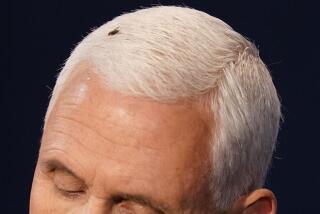Quayle Image Takes Nostalgic Trip to Less Ritzy Neighborhood : Convention: Foes mock the vice president’s wealth, but he is emphasizing a middle-class background.
- Share via
HOUSTON — He’s a father who goes home when others go to cocktail parties, a leader who’s not afraid to take on the sultans of Hollywood or the national news media. He’s a man so good-natured that he can laugh along at the unending drizzle of jokes at his expense.
And while political foes mock him as the immensely wealthy J. Danforth Quayle, he grew up in a “relentlessly middle-class background,” beginning in a two-bedroom, one-bathroom bungalow then worth $20,000.
This is the new image of Dan Quayle that is being pitched hard this week from the tumultuous venues of the Republican Convention. The portrait is being drawn by the vice president himself, his wife and numerous aides and friends. On Wednesday, it came via a series of speeches by and about him, including four at the convention. A biographical film clip will be shown to the convention today.
Although it is not yet clear whether the American voter will buy the new portrait, its aim is clear: to cast Quayle as a heartland father who lives the family values he preaches--maybe a little more determined, a little grittier, but an average American, nonetheless.
The film clip, produced by Mike Murphy Media Inc., begins with Quayle home-movie pictures of the vice president as a snowsuit-clad toddler outside a white, single-story home in what is by all appearances an average suburban neighborhood in Huntington, Ind.
“It was here, on Polk Street, where a young vet and his wife raised their family,” explains the announcer, referring to Quayle’s father, James.
The clip explains that the young Quayle was given his fancy-sounding name not because of his mother’s wealthy family but because his father wanted to name a son after a wartime buddy, James Danforth, who was killed in action.
Marilyn Quayle is interviewed and describes her husband’s hearth-hugging tendencies. “Other people go out to parties and cocktail parties every night of the week; Dan would come home to his family,” she said.
She describes how she and Quayle met. Both were going to night law school at DePauw University; during the day she worked for the Indiana attorney general’s office and he worked for the governor. They had a first date and “10 weeks later, we were married,” she explains.
Quayle is shown playing basketball with his three teen-age children. He speaks warmly about his 19-year marriage and confides: “I’ve got a wonderful marriage; God’s been good to me.”
Quayle chooses two themes to discuss in the video: family values and his battle with his tormentors in the liberal media. He’s shown at a lectern, thundering: “ . . . because moral values are what the American people care most about.”
A moment later he is explaining: “I’m not bashful in taking on Hollywood--I know they’re powerful, they’re influential. But I’m just asking, do we have to have this much sex, this much violence, in the movies?”
The new Quayle shown at the convention is a man who has kept his smile through years of other people’s jests. In a speech Wednesday morning, Marilyn Quayle told a group of Republican women that at home, Quayle and she laugh at some of the jokes at his expense.
“You’re able to laugh because you know the truth is Dan Quayle is one of the most able vice presidents this country has ever seen,” she said.
In appearances this week, Quayle has carried gentle self-mockery to a high art. The approach may be the best way to deal with a reputation for verbal gaffes that at this point is likely to be hard to shake, some political analysts say.
On Wednesday Quayle told the lunchtime audience at a Republican National Committee gala that Democratic nominee Bill Clinton had come to his home state to campaign against him.
“He challenged me to spell the word liberal ,” Quayle said. “Well, I can spell it: C-L-I-N-T-O-N-E.”
The joke, of course, was that Quayle had made headlines a few weeks ago by instructing a New Jersey schoolchild that “potato” was spelled with a final “e.”
Quayle has been praised this week by President Bush and former President Ronald Reagan. But it is Reagan’s praise that he mentions in speech after speech, suggesting that he wishes to identify himself as closely as possible with another good-natured politician.
Quayle’s aides too have been working to correct misinformation.
Just after he was nominated in August, 1988, Quayle’s personal wealth was estimated in several news reports as high as $600 million. David Beckwith, Quayle’s press secretary, said the vice president has a net worth of about $1 million, including the family’s $500,000 house in McLean, Va., which has a mortgage of more than $200,000. The remainder is primarily in stock, Beckwith said.
He describes Quayle’s childhood in Indiana and Arizona as “almost relentlessly middle class.” The vice president’s most luxurious childhood vacation, he says, took place when Quayle and his family spent two weeks in Yellowstone Park, and uncharacteristically went out to eat twice.
Since Quayle attacked the sitcom character Murphy Brown three months ago for deciding to raise a child without a husband, Quayle has been a target of feminists and others.
This week, even as he has called single mothers “heroes,” he has tried to reinforce his ties to women voters by choosing three women to second his nomination.
The three are Donna Sims, a divorced mother of three who wrote a letter of support to Quayle on the “Murphy Brown” issue; Charlene Haar, a U.S. Senate candidate from South Dakota, and Zora Brown, a breast-cancer victim whose fight against the disease was helped when the White House Council on Competitiveness, which Quayle heads, helped speed up FDA approval of a drug.
The new Dan Quayle is also a man who respects the aspirations of professional women.
In her speech Wednesday night, Marilyn Quayle said that, when her husband married her, “he married a budding lawyer. He wanted a partner--and he has one.”
Quayle believes that his 1988 introduction was hurt in part when he became too caught up in responding to an onslaught of press inquiries about his draft record, academic career and family background.
This time, to maintain tighter control, the vice president and his aides decided that instead of conducting two press conferences a day, there will be only one or two interviews a day, each with a TV network.
“We’re doing things on our terms this time,” a Quayle aide said.
More to Read
Get the L.A. Times Politics newsletter
Deeply reported insights into legislation, politics and policy from Sacramento, Washington and beyond. In your inbox twice per week.
You may occasionally receive promotional content from the Los Angeles Times.











